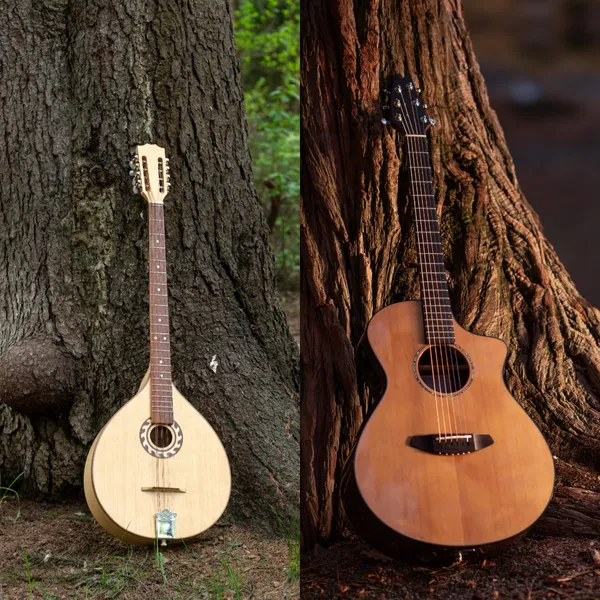

Irish Bouzouki vs Celtic Guitar: A Comparison in Trad Music
Both the Irish bouzouki and the Celtic guitar bring valuable qualities to traditional music, each offering strengths that cater to different musical roles.
The Irish bouzouki and Celtic guitar are two instruments that have become staples in traditional music, each offering something different to players and listeners. Whether you're a musician or simply curious about their roles, this article will break down their key differences and help you understand how they contribute to Trad music.
The Irish bouzouki and Celtic guitar serve different roles in traditional music. The bouzouki often provides percussive strumming and drones, supporting melody players, while the guitar offers more harmonic possibilities and rhythmic backing. Choosing depends on the sound and function you need.
Curious about which instrument better suits your playing style or the role each plays in Trad music sessions? We’ve got more insights to help you make an informed choice. Keep reading to learn how the Irish bouzouki and Celtic guitar compare in sound, technique, and versatility.
Origins and Development

The Irish bouzouki became part of traditional Irish music relatively recently, finding its way into the tradition in the mid-20th century. Adapted from the Greek bouzouki, it underwent modifications to better suit Irish melodies and rhythms. The instrument was retuned and reshaped to accommodate open tunings such as GDAD, allowing players to emphasize drone notes and modal harmonies. These changes gave the bouzouki a place in Irish music ensembles, where it added a new texture that complemented other instruments like fiddles and flutes.

The Celtic guitar, on the other hand, stems from the traditional acoustic guitar but is tailored for Celtic music through specific playing styles and tunings. One of the most common tunings associated with the guitar in this context is DADGAD, which facilitates the open, flowing harmony often heard in accompaniment. Guitarists often rely on fingerpicking patterns or strumming methods to support melodies or provide rhythmic structure. While not originally a traditional instrument, the acoustic guitar was quickly embraced for its flexibility, allowing musicians to adapt it for both accompaniment and occasional melodic roles in sessions and performances.
Playing Style & Technique
The Irish bouzouki is primarily played using a pick, enabling musicians to provide rhythmic accompaniment and sustain drone tones that complement traditional melodies. Its commonly preferred tuning, GDAD, emphasizes modal progressions, which are often at the core of Irish music. This tuning allows players to produce open chords that give the instrument a resonant, supporting role in ensembles. Techniques often focus on creating driving rhythms or subtle harmonic layers rather than intricate melodic lines, making the bouzouki a central part of the ensemble's foundation.
The Celtic guitar, adapted for folk traditions, incorporates alternate tunings such as DADGAD and CGCGCD to expand harmonic possibilities. Fingerpicking is a prominent technique used to add ornamentation, while flatpicking is more common when the guitar serves a rhythmic backing function. These tunings make it easier to access open strings and modal chords, aligning the guitar's sound with the characteristics of Irish and Scottish music. Players often use varied picking patterns to suit the mood or tempo of the performance, balancing between maintaining rhythm and adding melodic textures. As an accompanying instrument, the guitar’s adaptability has made it a staple in sessions, enabling players to complement fiddles, pipes, and other traditional instruments with ease.
Role in Trad Music
In traditional music settings, the Irish bouzouki plays a supportive role, complementing melody-focused instruments such as fiddles, flutes, and uilleann pipes. Its ability to provide rhythmic backing through strumming patterns and sustain key notes makes it a reliable partner for melody players. The bouzouki often fills gaps within the ensemble, creating a base of harmony and texture that ties the individual parts together. By emphasizing open chords and modal tunings, it bridges the harmonic framework without overshadowing the primary melodic voices.
The Celtic guitar offers flexibility in its contribution to traditional groups. It is often used to establish harmonic structure, supporting melody instruments by anchoring the chord progressions and filling space with either strummed or fingerpicked patterns. Compared to the bouzouki, the guitar has more potential for solo performance, allowing musicians to play melodies or add individual flair when needed. This versatility enables it to serve both as a backing instrument and, at times, as a melodic voice. In group performances, the guitar balances the mix by enhancing the arrangement’s harmonic depth, while its adaptability ensures it can blend seamlessly or stand out when required. This dual functionality has made it a staple in both ensemble sessions and solo interpretations of Celtic music.
Sound Comparison
The Irish bouzouki and Celtic guitar present distinct sound characteristics that often influence their roles in traditional music and listener preferences. The bouzouki produces a twangy, resonant sound that stands out for its longer sustain, making it particularly effective in creating textures that linger within a musical arrangement. Its tone is well-suited for modal harmonies and open chord voicings, contributing an accentuated quality to the music without dominating the ensemble. This makes it a preferred choice for adding atmosphere or complementing lead instruments.
In contrast, the Celtic guitar delivers a more balanced and fuller sound with a broader harmonic range. It has the ability to cover a wider scope of chords and tonal variations, which allows it to anchor the harmonic structure while also blending seamlessly with other instruments. The guitar’s adaptability makes it ideal for both providing accompaniment and stepping into a melodic role when necessary.
Choosing between the bouzouki and the guitar often depends on the musical setting and personal preference. Those seeking a more resonant, textural sound may favor the bouzouki, while others may opt for the guitar’s harmonic versatility and fuller acoustic presence. Different contexts, such as ensemble or solo performances, also play a role in shaping this preference.
Which One Should You Choose?

When deciding between the Irish bouzouki and the Celtic guitar, it’s important to think about your musical goals and playing style. Start by considering your role in a session—are you looking to accompany melody players or play something closer to a lead role? The bouzouki is often favored for accompaniment due to its ability to provide harmonic support with a bright and sustained quality. On the other hand, the guitar offers more flexibility, making it a great choice for players who want to balance accompaniment with occasional melodic contributions.
Tone preference is another factor. If you’re drawn to a punchy, ringing sound that emphasizes open chords and textures, the bouzouki might suit you better. If a fuller sound with the ability to explore a wider harmonic range appeals more, the guitar may be the right fit.
Comfort and familiarity also play a role—players who are more accustomed to standard guitar techniques may find the transition smoother with the Celtic guitar, while the bouzouki often requires learning alternative tunings and approaches. Ultimately, both instruments bring valuable qualities to traditional music, and your choice rests on how you want to engage with the music and your long-term goals as a player. Both are worthy additions to any musical tradition.
Final Thoughts

Both the Irish bouzouki and the Celtic guitar bring valuable qualities to traditional music, each offering strengths that cater to different musical roles and preferences. The bouzouki stands out for its sustained, bright sound that complements chord-based accompaniment and brings an expressive quality to arrangements. Its design and tuning provide opportunities for exploring open voicings, often enhancing the harmonic texture of a piece.
In contrast, the Celtic guitar is versatile, with a broader harmonic range and a more balanced acoustic presence. It seamlessly bridges accompaniment and melodic playing, making it a flexible option for musicians who want to take on different roles in a session. Its adaptability also appeals to players who might prioritize comfort with familiar techniques over learning new approaches.
Ultimately, the decision between these instruments depends on the player’s desired sound, intended role in music-making, and personal taste. Both have the potential to become key components of a musician’s repertoire, offering different ways to enhance and shape traditional music. Aspiring players are encouraged to experiment with both, exploring how their strengths fit into their playing style. By doing so, they can gain a better understanding of what resonates most with their musical goals.

What is Celtic Music?

